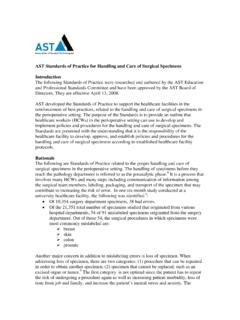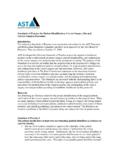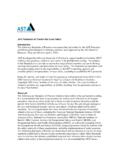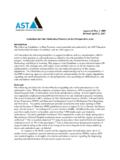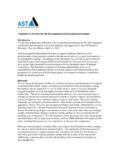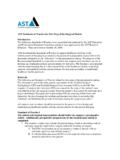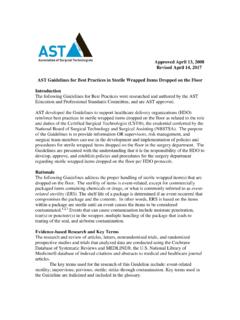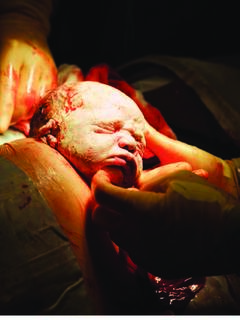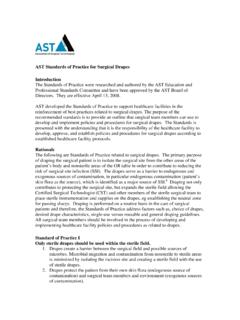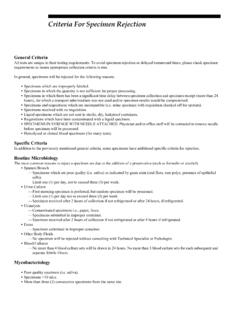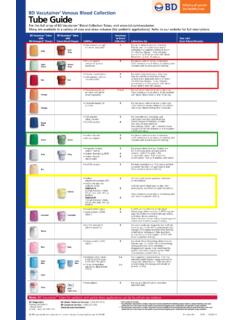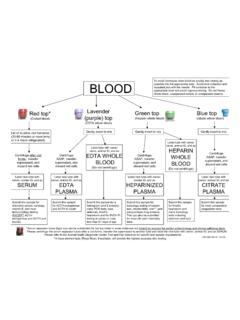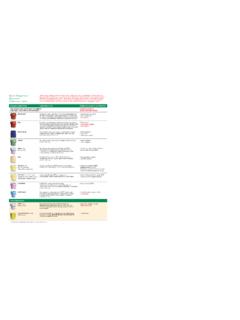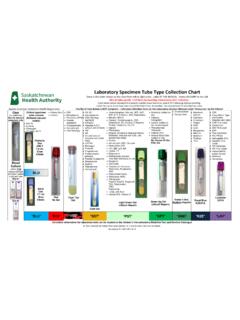Transcription of Total Abdominal Hysterectomy
1 Total Abdominal Hysterectomy Douglas Hughes, cst, crcst T. otal Abdominal Hysterectomy (TAH) is commonly used to treat patients suffering from a variety of pathologies, such as hem- orrhage, fibroids, Abdominal pain and various types of cancer. Approximately 500,000 hysterectomies are performed in the United States each Hysterectomy is indicated typically in the following three conditions: as a life-saving intervention, as a corrective procedure for serious function- al problems, and to improve the patient's quality of life. Some of the more common, specific indications for surgery include uterine cancer, ovarian cancer, cervical cancer, fibroids, endometriosis, prolapse, precancer of the uterus, pelvic adhesions, unusually heavy bleeding, and pelvic Hysterectomy may be performed either vaginally or abdominally, depending on the patient's diagnosis and age, the size of the uterus, and other related The Abdominal approach is most commonly employed when nearby structures, such as regional lymph nodes, must be examined, when the ovaries and fallopian tubes will be removed in conjunction with the uterus, and when large tumors are present.
2 The vaginal approach may be indicated when the size of the uterus is determined to be less than that during 12 weeks of gestation, when no other related pathology is suspected, and when the Hysterectomy will be done in conjunction with cystocele, rectocele, or enterocele repair, 3,13. This article will chronicle the preoperative, intraoperative, and postop- erative case management of a 38-year-old patient undergoing Total abdomi- nal Hysterectomy for treatment of large symptomatic uterine fibromata. PATIENT INFORMATION. The patient is a 38-year-old caucasian female approximately 5'3" tall who weighs 146 pounds. She has no known drug allergies and is currently taking nonsteroidal anti-inflammatory drugs to relieve menstrual cramping and APRIL 2007 The Surgical Technologist 157. 280 APRIL 2007 1 CE CREDIT. heavy menstrual bleeding.
3 She has also been tak- MEDICAL HISTORY. ing nonprescription iron supplements to correct The patient reported that her symptoms have anemia caused by fibroid-related blood loss. lasted approximately nine months and have The patient's blood type is O negative. The become progressively worse. Symptoms include patient has admitted to heavy illegal drug use dysmenorrhea, consistent episodes of urinary in the past, but indicates she has been free of frequency and urgency, Abdominal distension, any drug or alcohol use, including smoking, for chronic lower-back pain, and dyspareunia. No approximately eight months prior to surgery. trauma that may be associated with these symp- A pelvic examination done prior to admission toms was reported. FIGURE 1: revealed a uterine mass. Sonohysterography was The patient's medical history includes mild Total Abdominal later performed and confirmed the diagnosis of asthma, generalized anxiety disorder and a pre- Hysterectomy (TAH): uterine fibroids, leading to the current surgical vious cesarean section.
4 Division of round intervention. ligament. Current medications include: L Ibuprofen 400 mg every four hours L Ferrous sulfate 300 mg per day L Inhaled sympathomimetic 180 mcg (two inhalations) every four to six hours as needed L Benzodiazepine mg three times daily, not to exceed 4 mg per day PHYSIC AL CONDITION AT ADMISSION. The preoperative physical examination revealed that the patient was in good health and that she was well nourished. Her skin was warm, dry, had good texture, and was free of any notable lesions or abnormalities. Normal, wet mucosa was noted during evaluation of the patient's ears, nose and throat. No pathologies were encountered. An evaluation of the patient's neck produced normal results with no masses found. Auscultation of the lungs indicated they were normal and without congestion or other anoma- ly. Examination of the abdomen revealed palpa- Courtesy Thomson Delmar Learning.
5 Surgical Technology for the Surgical Technologist: A Positive Care Approach. 2004. ble masses and distention, though bowel sounds were normal. The patient's extremities were normal and without edema, cyanosis, other pathology, or vascular abnormality. No neurologic disorders were noted, and the patient was alert. Vital signs were normal and stable: Heart rate 84 bpm Respirations 18 breaths per minute Blood pressure 126/82 mm/Hg O2 saturation 98%. Temperature F. The Surgical Technologist APRIL 2007. 158. SURGERY INDIC ATED FIGURE 2: Round ligament Drugs on the field included 1,000 cc of normal Broad ligament . saline irrigation fluid, 30 cc of bupivacaine posterior and Courtesy Thomson Delmar Learning. Surgical Technology for the Surgical Technologist: A Positive Care Approach. 2004. with epinephrine for local anesthesia, and triple anterior leaves.
6 Antibiotic ointment (neomycin, polymyxin, and bacitracin zinc) for application with the dressing. ANESTHESIA. Prior to anesthesia induction, the patient's jew- elry and wristwatch were removed. General anesthesia was administered via an endotracheal tube. Vital signs and airway were managed, and the patient's level of consciousness was assessed. Nothing abnormal was reported. Posterior leaf of broad ligament Intravenous induction and maintenance agents used: L Midazolam Hydrochloride L Propofol preference card. Abdominal and vaginal prepa- L Fentanyl Citrate ration techniques were employed. An impervious drape with a reservoir was Inhalation agents used: placed under the buttocks to collect excess prep L Oxygen solution. Disposable towels were placed at the L Desflurane patient's sides. For the vaginal prep, a down- ward movement was used over the genitalia PATIENT POSITIONING and perineum.
7 Each sponge was discarded after The patient was transported to the via gurney prepping over the anus. The upper thighs, pubis, and transferred to the operating table with the assis- vulva, labia, perineum and anus were prepped. tance of the surgical team. Her head was placed on The vaginal vault was prepped with sponge sticks, a gel donut headrest. The patient was then covered and each was discarded after use. with a blanket for warmth and privacy. The abdomen was prepped beginning at the The patient was positioned in the supine posi- incision site (low transverse) and extending from tion with padding under bony prominences and a the nipples to midthighs, and laterally as far as restraint proximal to her knees to prevent falling. possible. This was accomplished using circular Arms were extended laterally on padded armboards motions starting from the incision site outward.
8 And were positioned to slightly less than 90 . A sterile, disposable towel was used to collect and A pulse oximeter was applied to the right dry any excess solution. index finger, and a blood pressure cuff to the upper right arm. The electrosurgical unit disper- DRAPING. sive pad was placed under the left buttock. Folded towels and a laparotomy drape were used to Following intubation and induction of anes- create the sterile field. Sterile blue towels were placed thesia, the blankets were repositioned, and a one-by-one around the planned incision site in Foley catheter was inserted. order to outline the area for placement of the drape. Towel clips were not used to secure the towels, as it SKIN PREPAR ATION was determined that they would not be needed. The patient had no known allergy to iodine- The protective strips were removed from the based chemicals, so a standard iodine prep solu- adhesive backing of the laparotomy drape, and it tion was used in accordance with the surgeon's was passed to the surgeon.
9 The drape was orient- APRIL 2007 The Surgical Technologist 159. FIGURE 3: was incised with curved Mayo scissors and Dissection line. reflected superiorly using two Kocher clamps. The bellies of the rectus muscles were dissected longitudinally, and the peritoneum was incised vertically with a #10 blade and toothed forceps, to elevate it from underlying structures. A medi- um Richardson retractor was used to aid in expo- sure of the operative site. Courtesy Thomson Delmar Learning. Surgical Technology for the Surgical Technologist: A Positive Care Approach. 2004. PROCEDURAL OVERVIEW. Once entrance into the peritoneal cavity was achieved, the uterus and surrounding structures were assessed for any unsuspected pathology. The adnexae, including the ovaries and fallopian tubes, were also assessed. The operating table was put in the Trendelenburg position to improve visualiza- tion of the Abdominal cavity and operative site.
10 The bowel was positioned away from the Posterior leaf of operative area and packed with five laparotomy broad ligament Rectum sponges moistened with warm normal saline. The surgical site was exposed with an O'Connor- O'Sullivan self-retaining retractor, which was ed for maximum exposure of the surgical site just placed into the Abdominal cavity. superior to the mons pubis. The sheet was slowly Short instruments on the Mayo stand were unfolded bilaterally and stabilized. The head of replaced by extra long instruments in order to the drape was extended and passed to the anes- reach deeper anatomy. Incorporating the round thesia provider, who fastened it to IV poles locat- and ovarian ligaments, Phaneuf clamps were ed on either side of the patient's head. The foot placed across each broad ligament close to the of the drape was extended downward beyond the cornu.
